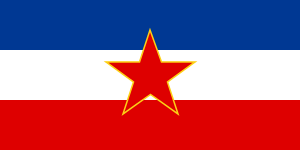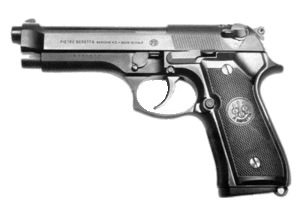Beretta Model 38
| Beretta Modello 38 | |
|---|---|
|
Moschetto Automatico Beretta Modello 1938 | |
| Type | Submachine gun |
| Place of origin |
|
| Service history | |
| Used by | See Users |
| Wars | World War II |
| Production history | |
| Designed | 1935 |
| Variants |
1938A 1938/42 1938/43 1938/44 1938/44 Special - Model 1 1938/49 - M2, M3 & M4 Model 5 |
| Specifications | |
| Weight |
MAB 38A: 4.2 kg (empty) MAB 38/42: 3.27 kg (empty) MAB 38/49: 3.25 kg (empty) |
| Length |
MAB 38A: 946mm MAB 38/42: 800mm MAB 38/49: 798mm |
| Barrel length |
MAB 38A: 315mm MAB 38/42: 213mm MAB 38/49: 210mm |
|
| |
| Cartridge |
9×19mm Parabellum (Cartuccia Modello 38) |
| Caliber | 9mm |
| Action | Blowback |
| Rate of fire | 600 rpm |
| Muzzle velocity | 429 m/s (1,407.1 ft/s) |
| Effective firing range | 250 m (273.4 yd) |
| Feed system | 10, 20, 30, or 40-Round Detachable Box Magazine |
The MAB 38 (Moschetto Automatico Beretta Modello 1938), Modello 38, or Model 38 and its variants were a series of official submachine guns of the Royal Italian Army introduced in 1938, and used during World War II. The guns were also used by German, Romanian, and Argentine armies of the period.
History
Originally designed by Tullio Marengoni in 1935, the Modello 38 (M38) was developed from the Beretta Modello 18, itself derived from the Villar Perosa light machine gun of World War I fame. It is widely acknowledged as the most successful and effective Italian small arm of World War II.
Italy's limited industrial base in World War II was no real barrier toward the development of advanced and effective small firearms since at the time most weapons did require large amounts of artisanal and semi-artisanal man-hours to be fine-tuned and made reliable by default. At this, Italian specialized workers excelled and the initial slow production ratio meant that the Model 38 only became available in large numbers in 1943, when the fascist regime was toppled and Italy split between allied-aligned co-belligerent forces and German collaborationists of the Italian Social Republic. During 1941 and 1942, this weapon was available almost exclusively to paratroopers, Blackshirts, tank crews and Carabinieri military policemen, given the need of all of the former to express high volumes of firepower in prolonged actions or to keep close-quarters combat superiority. The standard paratrooper of the Folgore airborne division was armed exclusively with this weapon, and the division gave outstanding combat results. Similarly, Blackshirt legions (one per infantry division) were regarded and used as elite assault units both for their fanaticism and their armament, in which the Beretta 38 bulked. Regardless of the tables of organization and equipment of a given unit, the Beretta 38 was a popular weapon that could eventually find its way into the hands of virtually any soldier, especially amongst officers and higher non-commissioned officers, notably in Bersaglieri light infantry, artillery and armoured units. However, this weapon remained a rare view amongst common infantry and Alpini mountain infantry.

Italy developed a dedicated magazine-holding vest for elite troops (Blackshirts, paratroopers) armed with the Beretta 38; these were dubbed "Samurai" due to the aesthetic similarity of the stacked magazines with traditional Japanese armour. However these only came into use during the brief life of the R.S.I. and by then could be seen in the employ of many different units whose "elite" status could have been reasonably questioned (such as Black Brigades and other militias).
The 1938 series was extremely robust and proved very popular with both Axis forces as well as Allied troops, who utilized captured examples.[1] Many German soldiers, including elite forces such as the Waffen-SS and Fallschirmjäger forces, actually preferred to use the Beretta 38 in combat.[2][3][4] Firing a powerfully loaded Italian version of the widely distributed 9×19mm Parabellum cartridge, the Cartuccia Modello 38, the Beretta was accurate at longer ranges than most other submachine guns.[5] Fully automatic or single-shot fire was selectable by the use of two triggers. The Model 38 had a wooden stock, was about 800 millimeters in length, and weighed about 3.3 kilograms when loaded, with an effective range of about 200 meters.
Variants


The Model 1938 can be recognized by its machined steel receiver, fine craftsmanship and finish, and by the perforated cooling jacket over the barrel.[6] It was produced from 1938 to 1950. It fired the 9×19mm Parabellum ammunition at a rate of 600 rounds per minute. It used 10, 20, 30, or 40-round magazines. The short 10-round magazine, when used in conjunction with the fixed bayonet, was popular with both Allied and Axis forces for guarding prisoners or internal security details.[5][7]
Despite its undeniable effectiveness, the Beretta Model 38 proved too time-consuming and expensive to produce during wartime. Marengoni designed a simplified model made from sheet steel, in which the cooling jacket and bayonet mount were eliminated, and the separate firing pin mechanism deleted in favor of a firing pin machined on the face of the bolt.[8][9] This new model the Model 38/42 had a fluted barrel to aid cooling and save weight. It also had a slower rate of fire (550 rpm). The Model 38/43, was an intermediate production stage between the 42 and 44 patterns.[10] The 38/42 and 38/43 were adopted by the German army as the MP.738.[9]
The Model 38/44 was a minor revision of the 38/43, in which the bolt was simplified and a large-diameter recoil spring utilized in place of the operating spring guide.[9] It also eliminated the fluting to save time and increase production.[9] The 38/44 was also adopted by the German army as the MP.739. A variant of the Model 38/44 was fitted with an MP40-style under-folding stock, and given the designation Model 38/44 Special or Model 1.
After World War II, the 38/44 continued in production in slightly revised form as the 38/49 series: the Model 2 with an MP40-style under-folding stock,[9] the Model 3 identified by telescoping steel-wire buttstock, and the Model 4 with a standard wooden rifle stock. All of these models have a push-button cross-bolt safety, located at the middle of the stock.[9] After Marengoni's death, Beretta engineer Domenico Salza revised the safety system of the Model 38/49 series, resulting in the Model 5, identified by a large rectangular grip-safety button located in the stock's finger groove.[11] The Model 5 was produced for the Italian Army and police, as well as the armed forces of several other nations until 1961, when production ceased in favor of the compact, modern Beretta M12.[11]
Users
 Costa Rica[12]
Costa Rica[12] Dominican Republic[12]
Dominican Republic[12].svg.png) Empire of Japan: 350 ordered and 50 delivered in 1943.[13]
Empire of Japan: 350 ordered and 50 delivered in 1943.[13] Ethiopia[12]
Ethiopia[12].svg.png) Italy[2]
Italy[2]
 Italian Social Republic[14]
Italian Social Republic[14] Italian Resistance
Italian Resistance
 Morocco[12]
Morocco[12].svg.png) Nazi Germany[15]
Nazi Germany[15] Romania: 5,000 ordered in 1941 and delivered during 1942.[15][16]
Romania: 5,000 ordered in 1941 and delivered during 1942.[15][16] Yemen[12]
Yemen[12] Yugoslavia: Captured in vast quantities.[17]
Yugoslavia: Captured in vast quantities.[17]
See also
References
- ↑ Dunlap, Roy F., Ordnance Went Up Front, Samworth Press, (1948), p. 58
- ↑ 2.0 2.1 Miller, David. Fighting Men of World War II, Volume I: Axis Forces--Uniforms, Equipment, and Weapons (Fighting Men of World War II). Stackpole Books. pp. 139, 353. ISBN 0-8117-0277-4.
- ↑ Quarrie, Bruce, Fallschirmjäger: German Paratrooper, 1935-45, Osprey Publishing (2001), ISBN 1-84176-326-8, ISBN 978-1-84176-326-2, p. 59
- ↑ Ordnance Went Up Front, p. 58: "No one ever bothered with any other kind of submachine gun if he could get hold of a Beretta M38, and keep it. The New Zealand boys especially loved them. Even the Germans liked it, and they hated to admit anything was good except their own stuff."
- ↑ 5.0 5.1 Ordnance Went Up Front, p. 58
- ↑ Hogg, Ian V. and Weeks, John, Military Small Arms of the 20th Century, 6th ed. DBI Books, Inc. (1991), pp. 224-225
- ↑ Smith, Joseph E., Small Arms of the World, 9th ed., Harrisburg, PA: The Stackpole Company (1969), pp. 482-483
- ↑ Hogg, Ian V. and Weeks, John, Military Small Arms of the 20th Century, 6th ed. DBI Books, Inc. (1991), pp. 224-225
- ↑ 9.0 9.1 9.2 9.3 9.4 9.5 Small Arms of the World, pp. 544-546
- ↑ Hogg, Ian V. and Weeks, John, Military Small Arms of the 20th Century, 6th ed. DBI Books, Inc. (1991), pp. 224-225
- ↑ 11.0 11.1 Military Small Arms of the 20th Century, pp. 224-225
- ↑ 12.0 12.1 12.2 12.3 12.4 Jones, Richard (2009). Jane's Infantry Weapons 2009-2010. Jane's Information Group. pp. 894–905. ISBN 0-7106-2869-2.
- ↑ "ITALIAN-JAPANESE MP 38/43 MACHINE PISTOL". Dragons of Fire. Retrieved 2011-12-10.
- ↑ Jowett, Phillip (2001). The Italian Army 1940-45 (3): Italy 1943-45 (Men-at-Arms) (v. 3). Osprey Publishing. p. 17. ISBN 1855328666.
- ↑ 15.0 15.1 Bishop, Christ (2002). The Encyclopedia of Weapons of WWII: The Comprehensive Guide to over 1,500 Weapons Systems, Including Tanks, Small Arms, Warplanes, Artillery, Ships, and Submarines. Metrobooks. p. 262. ISBN 1-58663-762-2.
- ↑ Mark Axworthy,Third axis, fourth ally, page 76
- ↑ Vuksic, Velimir (2003). Tito's Partisans 1941-45. Osprey Publishing. p. 60. ISBN 1841766755.
Further reading
- Dunlap, Roy F., Ordnance Went Up Front, Samworth Press, (1948) ISBN 1-884849-09-1
- Hogg, Ian V. and Weeks, John, Military Small Arms of the 20th Century, 6th ed. DBI Books, Inc. (1991), ISBN 0-87349-120-3
- Smith, Joseph E., Small Arms of the World, 9th ed., Harrisburg, PA: The Stackpole Company (1969), ISBN 0-8117-1566-3
| |||||||||||||||||||||||||||||
| ||||||||||||||||||||||||||

